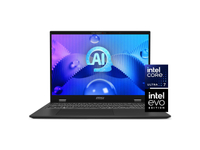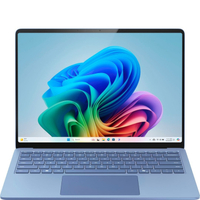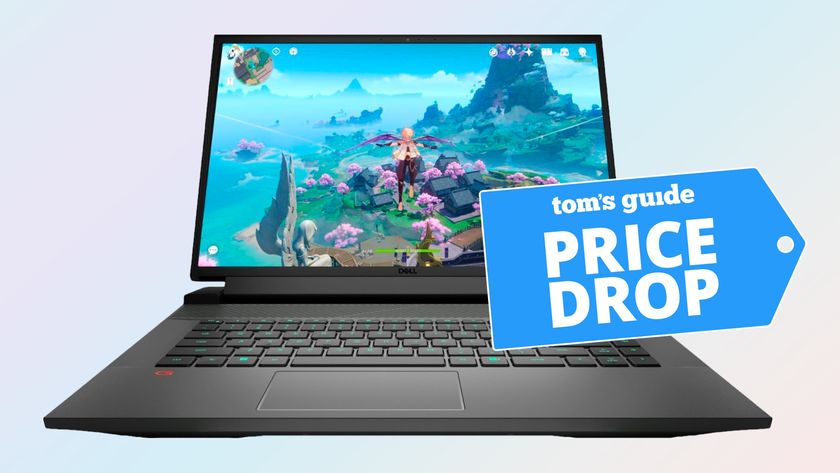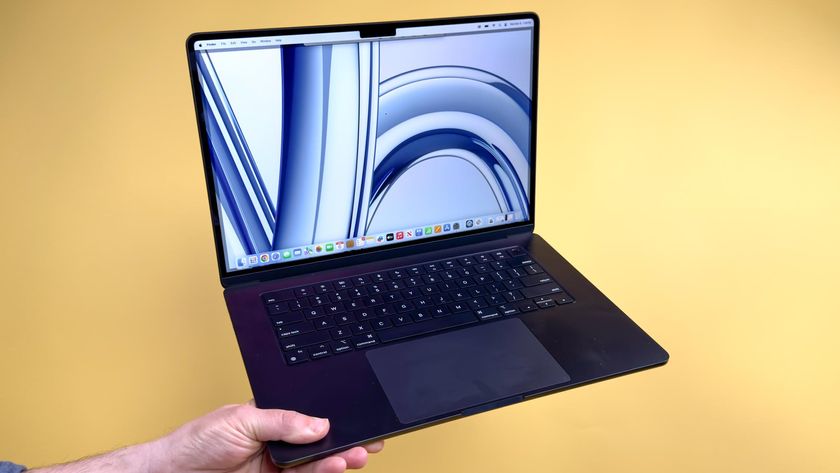I review over 200 laptops each year — here are the best laptops of 2025
These are the best laptops we recommend, based on testing dozens of models from Apple, HP, Lenovo, Microsoft and more.
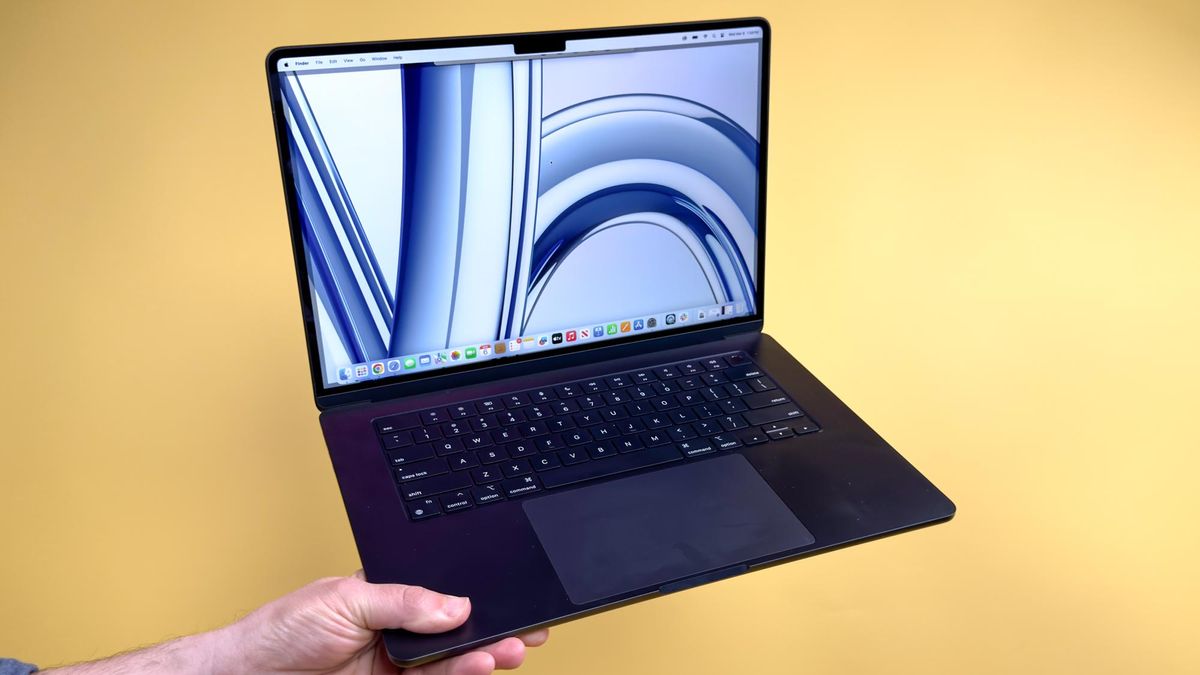
- My top picks
- Best overall
- Best value
- Best for Windows
- Best Copilot laptop
- Best Chromebook
- Most repairable
- Best for gaming
- Best battery life
- Best MacBook Air alternative
- Best 2-in-1
- Best MacBook Pro alternative
- Best MacBook Pro
- Also tested
- Battery life results
- How to choose
- Frequently asked questions
- How we test
I've been obsessed with finding the best laptops since my white plastic MacBook back in 2006. Reviewing 200 of them every year, people tell me I have a problem, but more fool them because I can use that expertise to help you find the best option for your needs.
From productivity powerhouses with the stamina to last you all day, budget laptops that cover the essentials for dirt cheap, all the way to gaming systems with all-out horsepower, I'm always finding the absolute greatest picks for you.
My top picks
The Snapdragon X Elite Dell XPS ticks the boxes of a great laptop for on-the-go work — super speedy internals and a super long battery life.
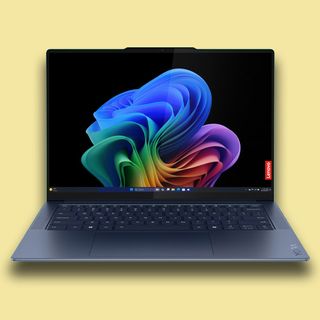
Keen to binge watch as well as work? The mesmerizing OLED display on the Lenovo Yoga Slim 7x combines with the Snapdragon X Elite chip for a super performant ultraportable.
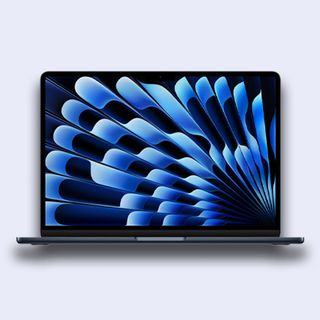
Yes, the M4 MacBook Air is just around the corner. But this continues to be one of the best laptops you can buy — paired with great value for money (thanks to all the great deals you can get).
To help you on your way, here are some key questions you need to ask yourself before picking.
What is the best laptop for me?
To find the best laptop for your needs, we need to know what you're going to do with it and where you plan to use.
Work & Productivity: If your #1 priority is having a portable PC you can use to answer email, prepare documents and get work done on the go, you want a modern ultraportable that's light, comfy to use and offers great battery life. I generally recommend the MacBook Air M3 (macOS) or the Dell XPS 13 (Windows 11) for this, and you can upgrade to models with bigger screens if you want more room to work.
Gaming: If you plan to spend a lot of time gaming, you want a laptop with a speedy CPU, a discrete graphics card and plenty of RAM. If you plan to play at higher than 60 frames per second, a screen with a high refresh rate is also great. Personally, I recommend the Asus ROG Zephyrus G14 since it satisfies all these requirements.
Creative work: If you plan to do a lot of 3D work, video editing or demanding content creation you will want a laptop that's very similar to a gaming laptop, with a powerful CPU, a discrete GPU and plenty of RAM to handle demanding workloads. A great screen is also nice to have, and I recommend the MacBook Pro (14-inch M4) or the Asus ProArt P16.
Casual use: If you just need a laptop for basic word processing, browsing the web and binge watching your favorite shows, you can save yourself a lot of money with a budget-friendly laptop. I recommend the Acer Aspire Go 15 if you prefer Windows, or the Lenovo Flex 5i Chromebook Plus if you're okay with a Chromebook.
Should I buy a MacBook, Windows laptop or a Chromebook?
Buy a MacBook if you are comfortable using Macs or are already embedded into the Apple ecosystem. While macOS is not as robust as Windows when it comes to gaming, many people find it easy to use and it's tightly integrated with Apple's other products, so your iPhone and AirPods will seamlessly interface with your Mac.
Buy a Windows laptop if you need access to the widest selection of apps, are not tied down to any particular ecosystem, want the best gaming experience and are looking for the broadest selection of laptop designs. Only Windows laptops come with features like touchscreens, high-speed displays or the option to transform into a tablet.
Buy a Chromebook if your work and entertainment needs revolve entirely around a browser. If everything you do is within a Chrome browser, then a Chromebook is the most direct (and cheap) way to get there. Just be aware you'll be limited to that browser window—ChromeOS is a robust operating system, but without Internet access it can't do much.
The best laptops you can buy today
Why you can trust Tom's Guide
The best laptop overall
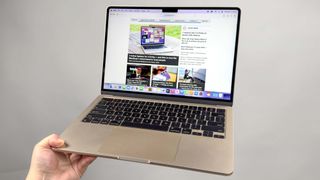
Specifications
Reasons to buy
Reasons to avoid
| Test | Notes | How it stacks up |
|---|---|---|
| Battery life | 15:13 tested battery life | ★★★★★ |
| Performance | Speedy, good for light work | ★★★★☆ |
| Design | Thin and elegant, light on ports | ★★★★☆ |
| Display | Bright, colorful 13.6-inch panel | ★★★★☆ |
What you need to know
The MacBook Air M3 is an excellent all-rounder that feels truly worthy of being called the best MacBook. Though it's virtually indistinguishable from the excellent MacBook Air 13-inch M2 that previously topped this list, the M3 variant is hard to dismiss.
The MacBook Air M3 (from $1,099) is a breath of fresh you-know-what, and that’s because Apple paired that speedy M3 chip with the same ultraportable design of its predecessor. It's a potent blend of performance and portability, one we recommend as one of the best laptops for getting work done on the go for most folks.
Buy it if
✅ You need a long-lasting laptop: The MacBook Air M3 lasted more than 15 hours in our battery test, which is longer than its predecessors.
✅ You want a small, fast MacBook: The M3 chip inside this MacBook Air gives it more than enough power for multitasking, and it pairs well with the long battery life and light weight.
Don't buy it if
❌ You want to play games: While this laptop does a stellar job of running games optimized for Apple silicon, non-supported games have trouble running at acceptable frame rates.
❌ You own a MacBook Air 13-inch M2: The MacBook Air M3 is certainly powerful, but only slightly faster than M2.
The bottom line
💻 The MacBook Air M3 is a bit pricey, but it justifies the premium with an unbeatable combination of performance, battery life, display quality and portability.
The review diary
Read the deep dive ▼
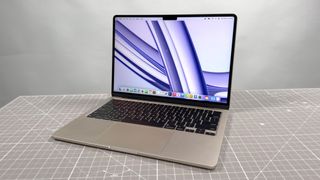
After one week
My first week with the M3 MacBook Air was spend just figuring out how Apple has managed to cram so much performance and power efficiency into a shell as slim, premium and light as this! At 2.7 pounds and just 0.4 inches thin, this is shockingly easy to throw into my backpack and head for the subway.
What's also really impressive is the versatility of what you can do with the Air. Whether I was working hard or hardly working (sorry, boss), I just had a great time with this machine.
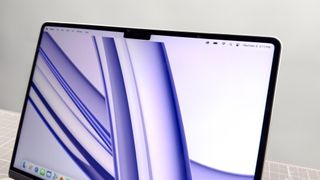
My workload is all over the place — usually including a lot of Photoshop editing, Final Cut Pro rendering, around 20+ Chrome Tabs and Apple Music pumping out some 00s emo albums (don't judge me). The M3 chip keeps everything super zippy in intense multitasking scenarios like this.
To put our lab testing to this, the Air hit 3,082 on the single-core CPU test and 12,087 on multi-core in Geekbench 6. Plus, it does it all while keeping impressively cool without the need for a fan.
But what about when you clock off? That display is impressively bright at 476 nits and colorful with a 109.8% color gamut that it quickly became my go-to screen for those moments when you want to watch a movie but can't be bothered to get out of bed to go to the living room. Plus, M3 is a surprisingly strong performer when it comes to gaming too — keeping frame rates smooth when hours deep in a Lies of P session.
After one month
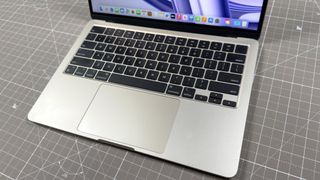
With a few more weeks under my belt, you really start to appreciate the package as a whole over the sum of its parts. This all begins with what I call "worry-free battery life." Normally, if I'm out and about with my laptop, I'm always hunting for power outlets in my peripheral vision to run over and plug into.
With the M3 Air's battery life reaching over 15 hours in our own testing, that's not a problem for literally the whole day. It felt so liberating, and I may have chuckled at other people doing the outlet shuffle in my local cafe (schadenfreude is a wonderful thing).
On top of that, you may think that the keyboard has got to be shallow in a thin laptop like this, but the key depth and tactile feeling makes typing an absolute joy. And that goes double for the ocean of a trackpad you get here.
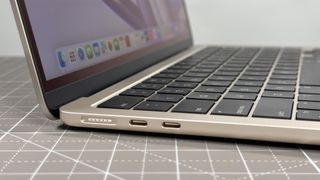
But I was reminded of two frustrations. First, going back to my Photoshop work, the limited port array meant I had to live the dongle life to connect my SD card. Apple, would it kill you to add an SD card slot to the MacBook Air?
And second, I looked at this from a different perspective. In comparison to the M2 MacBook Air, the performance gains are actually pretty minor. So if you already have the previous model, you don't need to upgrade.
Oh, and let's not forget that the M4 MacBook Air is imminent. It does mean that the M3 Air is cheaper than ever, but if you're obsessed with having the latest and greatest hardware (like me), I recommend waiting.
Read the full review: MacBook Air 13-inch M3
The best value laptop
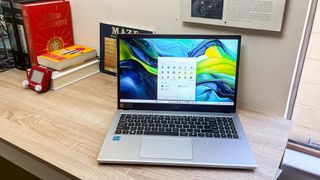
Specifications
Reasons to buy
Reasons to avoid
| Test | Notes | How it stacks up |
|---|---|---|
| Battery life | 10 hours of tested battery life | ★★★★☆ |
| Performance | Underpowered CPU causes this laptop to bog down easily | ★☆☆☆☆ |
| Display | 1080p LCD display is good enough but washed-out and a bit dim | ★★★☆☆ |
| Design | Thicker and heftier than modern ultraportables, but still plenty portable and attractive | ★★★☆☆ |
What you need to know
The Acer Aspire Go 15 is easily one of the best budget laptops you can buy, for better and for worse. At $299, you get a thick-set 15-inch ultraportable with a spacious keyboard, plenty of ports and 10+ hours of tested battery life.
Of course, you have to make some trade-offs when you buy this laptop. The speakers aren't very good, the low-res webcam makes you look washed-out and performance in anything but writing and browsing the web is pretty disappointing.
But if you can live with those compromises you get a pretty useful laptop for not very much money. It's the kind of thing I'd recommend a parent give a child as their first laptop, as it's great for surfing the web and doing homework. Remote learning, office work and research are all easy to do on this affordable 15-incher, but don't expect to play games or run apps more complicated than Minecraft.
Buy it if
✅You need a Windows 11 laptop under $500: The Acer Aspire Go 15 is one of the best laptops under $500 you can get, in my opinion, because it delivers all the utility of a Windows ultraportable for $299. If you need a cheap laptop for school or getting basic work done, this is a great choice.
✅ You need a versatile productivity machine: Acer's Aspire Go 15 can feel sluggish and can't run demanding games or apps, but what it can do is handle web surfing, writing, schoolwork and emails. The keyboard is surprisingly spacious and comfy and you get a versatile array of ports to boot, making this cheap laptop surprisingly good for school and office work.
Don't buy it if
❌ You can't stand sluggish PCs: The Acer Aspire Go 15 can help you get work done, but it won't do it quickly. The weak Intel Core i3-N305 CPU in our review unit chugged if I opened too many Chrome tabs or apps at once, and forget about playing any but the simplest of PC games.
❌You want to look good on video calls: The cheap 720p webcam built into the Acer Aspire Go 15 is just not very good. It's serviceable if you need to have a chat with colleagues or family, but you won't look your best.
The bottom line
💻 The Acer Aspire Go 15 is a cheap Windows laptop, in both good and bad ways. Luckily, the parts of it which feel cheap in a bad way aren't dealbreakers unless you really can't stand a slow laptop. But if you can make peace with its underpowered performance, the Go 15 will reward you with a sturdy, versatile Windows experience that can last 10+ hours on a full battery, according to our testing.
The review diary
Read the deep dive ▼
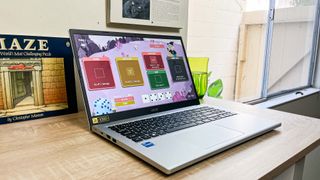
After one week
When it comes to buying a cheap laptop, the first thing you notice is the build quality. There's simply no escaping the fact that it is a hunk of plastic — chunkier and heavier than your average 15-inch laptop at 0.74-inches thick and weighing 3.86 pounds.
But once I got off my high horse about that, you realize that Acer has focused its efforts on what matters here. The plain silver gives off a utilitarian aesthetic that doesn't look cheap if you're pulling this out in a cafe or meeting room. It's the design equivalent of shopping at Shein.

That doesn't mean the fundamentals have gone forgotten here, though, as the keyboard has a shockingly good tactile feel to it for a $300 machine, and there's a decent port array with two USB-A ports, a USB-C, HDMI and a 3.5mm headphone jack — everything you need to get stuff done.
However, the first real obstacle you run into is that Intel Core i3 chipset. You've really got to keep an eye on how many apps you keep open, as anything above two programs or 10+ Chrome tabs really starts to slow this machine down.
It was quite the pain when trying to watch a tech live stream and report on it at the same time.
After one month

While I kept running into the walls of the laptop's performance capabilities, one thing I ended up appreciating during the next few weeks was the battery life.
Cheap laptops usually have the stamina equivalent of me daring to get on a running machine (I'll leave the fitness to the fitness team, as I'm more concerned with fit'ness burger in my mouth).
But with over 10 hours of longevity in our own testing, this can keep up with a whole working day away from the charger.
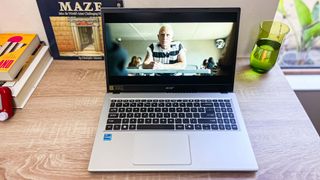
And finally, let's talk about the display here. If you're going for a budget laptop, you've got to understand that this is usually the area where the most compromise happens. With that in mind, the 15.6-inch LCD panel on here does show its cheapness in being dim and a little washed-out color-wise.
However, that 1080p resolution is crispy, the 60Hz refresh rate is smooth enough to not feel slow and the general tuning of the display is good enough for diving down a YouTube wormhole when you're supposed to be working.
Read the full review: Acer Aspire Go 15
The best Windows laptop

Specifications
Reasons to buy
Reasons to avoid
| Test | Notes | How it stacks up |
|---|---|---|
| Battery life | 19:41 tested battery life | ★★★★★ |
| Performance | The latest Snapdragon CPUs give it plenty of speed | ★★★★★ |
| Display | OLED would be nice, but at least this screen gets bright | ★★★★☆ |
| Design | Easy to carry but needs more ports | ★★★☆☆ |
What you need to know
The Dell XPS 13 hits a sweet spot between portability, price and performance in a Windows laptop.
We've long loved the excellent compromise between portability and screen size that is the XPS 13, and the 2024 model maintains that killer look while upgrading to a killer Snapdragon X CPU that delivers outstanding battery life.
While the row of capacitive touch function keys and the invisible touchpad are controversial design choices that take some getting used to, those that do will be rewarded with one of the best Windows laptops you can buy. The 2024 Dell XPS 13 may only have a pair of USB-C ports and little else in the port department, but if you just need a fast, lightweight Windows 11 machine for getting things done on the go, this is a great choice.
Buy it if
✅ You want a great Windows laptop: There are many great Windows laptops out there, but the Dell XPS 13 shines with its winning combo of svelte design, performance and portability.
✅You want great battery life: The Snapdragon X chip helped our review unit last nearly 20 hours (19:41) in our battery test, which is incredible for a Windows laptop. If you want all-day battery life, get an XPS with Snapdragon inside.
✅ You don't use a lot of peripherals: The XPS 13 only offers two USB-C ports, one of which you need to use when charging the laptop, so it's not great for folks who like to plug in a lot of devices.
Don't buy it if
❌ You like physical keys: The Dell XPS 13 has no physical function keys, instead sporting a touch-sensitive bar with light-up capacitive touch keys in its place. So if you hate capacitive touch keys, don't buy this laptop.
❌ Ports are important: The XPS 13 sports 2 USB-C ports, and that's it. You don't even get a headphone jack (though it does come with an adapter that lets you plug some into a USB port), so if you value ports don't buy this laptop.
The bottom line
💻 The Dell XPS 13 is an excellent Windows laptop that's perfect for work thanks to its light weight, speedy performance and incredible battery life.
The review diary
Read the deep dive ▼
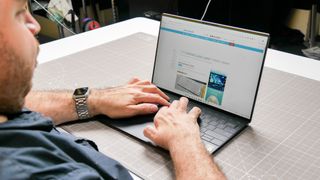
After one week
Look, Dell. I know you've made a great laptop here in the XPS 13 — it's actually one of my favorites. But removing the 3.5mm headphone jack is a daft decision.
But rant aside, my first week was spent just falling in love with those alluring lines and futuristic utilitarian aesthetic of that edge-to-edge keyboard. Plus, it's all crammed into a seriously slim shell (0.6 inches) that is super lightweight 2.6 pounds.
Plus that aluminum build paired with Gorilla Glass 3 gave me confidence in the durability to throw it straight in my backpack to travel to the office.
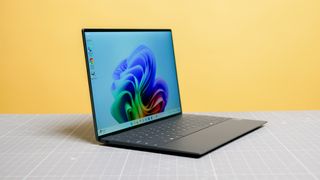
But then, I unleashed the real superpower here, and its name is Snapdragon X Elite (specifically the top of the range chip that's catchily named X1E-80-100). For the past 30 years, Windows PCs have used x86 chips from Intel and AMD, which are great for crushing tasks but not so great on battery life.
Qualcomm has waded in and changed the whole game with its Arm-based Snapdragon chips — giving laptops peak performance and power efficiency. With over 30 Chrome tabs, a YouTube video running in the background and some Photoshop editing going on, this more than held its own.
Top that off with a bright, sharp and colorful display, and this is great all-rounder for your work by day and watching whatever shows you love by night (my fiancée is showing me Temptation Island...it's quite something).
After one month
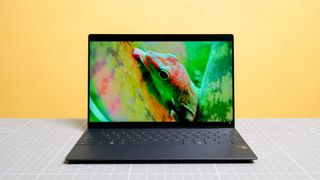
In our battery life testing, we found the XPS 13 lasted a whopping 19 hours and 41 minutes. That takes it well into worry-free territory, and I took full advantage of this while out and about — working from cafes, bars and even getting some nods of approval from the other customers are my rather sexy laptop.
But two of these design decisions take a little bit of getting used to. First, the keyboard took me a couple weeks to acclimatize to the lack of space between keys. I normally feel for those edges to touch type, and since every key is squished together, it's easy to get lost on the board!
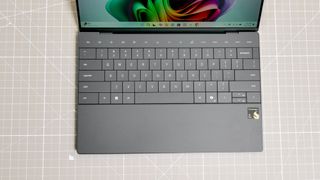
And second, there is no outline around the touchpad. It's not that it's bad — the tactile feel and smooth surface make it a great clicker. But it's camouflaged almost too well into the deck.
After a month, I felt confident that I just saw the future of laptop design. There are definitely some elements that I'd vote against in this future, like the touch-sensitive function row over actual keys and the lack of a headphone jack. But these frustrations melt away.
Read the full review: Dell XPS 13 (2024) review
The best Copilot laptop
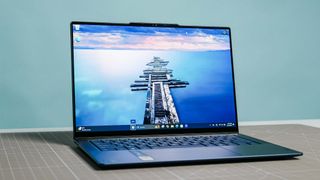
Specifications
Reasons to buy
Reasons to avoid
| Test | Notes | How it stacks up |
|---|---|---|
| Battery life | 14:14 tested battery life | ★★★★★ |
| Performance | The Snapdragon X Elite chip delivers stellar performance | ★★★★★ |
| Display | Its 14.5-inch (2,944 x 1,840) OLED display is one of the big selling points | ★★★★★ |
| Design | This ultraportable laptop is light and thin enough to carry around all day | ★★★★★ |
What you need to know
The Lenovo Yoga Slim 7x is a Windows 11 laptop built for portability and efficiency.
Thanks to its Snapdragon X Elite chip, you'll get more than all-day battery life and enough performance to power through your regular workload. The OLED panel is a marvel to behold, and its ultraportable design makes it easy to travel with. For $1,199, it offers an excellent value all around.
Buy it if
✅ You want a great Copilot+ laptop: Copilot+ PCs with Snapdragon X Elite chips are great, but the Lenovo Yoga Slim 7x delivers a great combination of portability, performance and battery life.
✅You want an OLED display: The Lenovo Yoga Slim 7x's OLED display is one of its strongest attributes. It delivers vibrant colors and deep contrasts at a sharp 2,944 x 1,840 resolution.
✅ You want dependable battery life: The Yoga Slim 7x lasted for 14 hours on our battery life test, which is well more than you'll need for a full workday — with enough left over to stream some videos.
Don't buy it if
❌ You expect useful AI features: This is an issue with all Copilot+ PCs at the moment, but the advertised AI features this laptop supports aren't fully realized yet. As such, don't expect this laptop to deliver in that regard.
❌ You want a headphone jack: If you want to listen to music or videos without bothering your neighbors then you'll need to use a pair of wireless headphones since this laptop doesn't have a headphone jack.
The bottom line
💻 The Lenovo Yoga Slim 7x is arguably the best Copilot+ PC thanks to its ultraportable design, fast performance, gorgeous OLED panel and phenomenal battery life. Best of all, it won't break the bank.
The review diary
Read the deep dive ▼
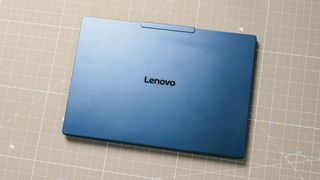
After one week
It's rare that a company thinks about everything when building an ultraportable laptop, which is what made the Lenovo Yoga Slim 7x so special to me for the first week.
At 12.8 x 8.8 x 0.5 inches and weighing 2.8 pounds, this sturdy aluminum laptop is supremely small, thin and light. And that Cosmic Blue finish looks so damn sexy...is it weird I call a laptop sexy? Probably, but I'm sticking with it.
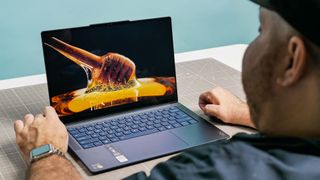
But then, I opened it up and I was greeted by the 14.5-inch 3K OLED display. These pictures simply do not do it justice — a whopping 901 nits for any HDR content and a pure flash flood of color with a 155% DCI-P3 color gamut. Put simply, this is a true feast for the eyes to savor.
Then, you realize just how zippy this thing is too with Snapdragon X Elite inside. Rendering video in CapCut, editing in Photoshop, running Apple Music and 10 Chrome tabs at the same time did absolutely nothing to slow it down!
And all of that comes with battery life that gave me no hesitation in taking this machine out and about with me for long periods away from plugs. Putting data to that, the Slim 7x lasted over 14 hours on one charge in our testing.
But once again, no headphone jack. Is it too far fetched for me to just want something to connect my cans to?!
After one month
A few weeks later, I got to appreciate a lot more of the finer details of this laptop's supreme capabilities — along with more of its smaller frustrations too.

Lenovo's always been well known for having the best keyboards in the business, and the Yoga Slim 7x is no different. Every key press feels gorgeously tactile and the subtle dish is perfect for touch typing.
Also, while I'm bummed about the lack of a headphone jack, those speakers are a lot better than I imagined them to be. With strong bass production for a warm sound, these even give the MacBook Pro a run for its money.
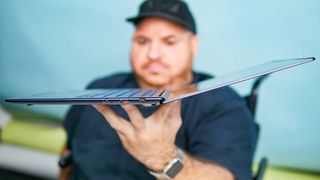
But then, I started running into one key obstacle — app compatibility. Given this is a new kind of chip compared to what Windows 11 has usually ran on, there is a translation layer that should emulate x86 apps for it. And with this you'll get three different results: it'll work but performance is hampered, it'll load up then bug/crash out, or it just won't open.
Plus, with the big strides made in integrated graphics in Intel and AMD chips, the poor performance in casual games here is a bit of a setback.
Read the full review: Lenovo Yoga Slim 7x
The best Chromebook
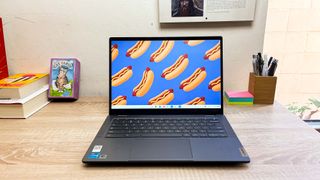
Specifications
Reasons to buy
Reasons to avoid
| Test | Results | How it stacks up |
|---|---|---|
| Battery life | 7:36 tested battery life | ★★★☆☆ |
| Performance | Not good for much besides browsing and light work | ★★☆☆☆ |
| Display | 14-inch 1200p touchscreen is nice and bright | ★★★★☆ |
| Design | Plenty of ports, a comfy keyboard and low-key unassuming design make this a great work laptop | ★★★☆☆ |
What you need to know
The Lenovo Flex 5i Chromebook Plus is the best Chromebook that I recommend most often to folks shopping. It does everything a Chromebook can do rather well, from basic office work to watching videos and streaming games.
Buy it if
✅ You want a Chromebook that turns into a tablet: The Lenovo Flex 5i Chromebook Plus can fold 360 degrees to function like a hefty Chrome tablet. It's harder to type on, but more comfortable to hold in some situations and also easier to tent when watching movies.
✅You expect to type a lot: Keyboard quality can be hit or miss on Chromebooks, especially 2-in-1s, so I'm pleased to report I really enjoyed my time typing on the Lenovo Flex 5i Chromebook Plus thanks to its spacious, well-designed keyboard.
Don't buy it if
❌ You need oodles of battery life: The Lenovo Flex 5i Chromebook Plus lasted under 8 hours (7:36) in our battery test, so I can't recommend it if you need a laptop with all-day battery life. However, if you can bear to lug the charger along it at least charges quickly.
❌ You need great performance: Chromebooks are rarely very powerful, and this one isn't amazing in that department. While it's faster than many competing Chromebooks, the Lenovo Flex 5i Chromebook Plus is a poor choice if you plan to do demanding work like audio/video editing, production work, game development or the like.
The bottom line
💻 The Lenovo Flex 5i Chromebook Plus is a great value, giving you a lovely 1200p 16:10 touchscreen, a comfy keyboard and enough ports for all your accessories in a a very affordable package. It's not the best laptop on the market, but it is the best Chromebook right now.
The review diary
Read the deep dive ▼
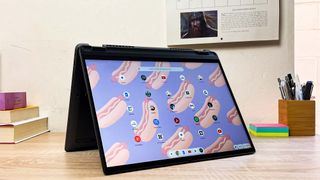
After one week
OK, I'll be real. Chromebooks have never been my favorite laptops — always being super restricted in what they can do. But to be honest, the Lenovo Flex 5i Chromebook Plus gave me a whole new appreciation for ChromeOS by showing me just what Google's software is now capable of in a sleek package.
At 0.8 inches thin and weighing 3.6 pounds, this is a sleek machine given the fact it's a full blown convertible 2-in-1 with a touchscreen panel. And that 14-inch panel is super responsive to multitouch gestures to move around ChromeOS at speed.
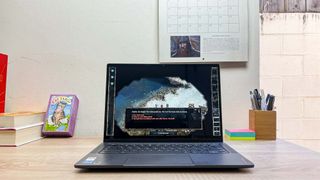
Plus, when you've got it in the standard laptop mode, that keyboard feels gorgeous to type on, and given the reduced pressure of ChromeOS, that Intel Core i3 feels positively speedy under the hood.
Since a lot of my work revolves around Chrome, I was able to crush all my tasks with multitasking ease and not feel any slowdown at 20 tabs.
After one month

A few weeks passed and I found more of those "just Chromebook things" that I both appreciated and got a little frustrated by.
First of all, those Chromebook Plus AI features are not only really clever ways to cut some corners in the work you do and for brainstorming, but it's neatly integrated into a right click context-aware menu.
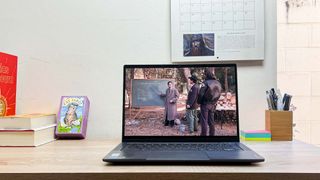
But these seem to have compromised the battery life. Sitting at my local bar and getting some work done ended up with me reaching for a charger stat after a couple hours. With battery life peaking at over 7.5 hours in our screen-on test, any more pressure brought this down further.
And I don't know about you, but you give us a 2-in-1 laptop that is the perfect easel for creative work, but you don't give us a stylus in the box? That feels a little stingy.
Read the full review: Lenovo Flex 5i Chromebook Plus
The best laptop to repair and upgrade
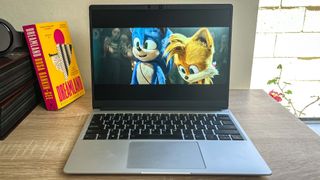
Specifications
Reasons to buy
Reasons to avoid
| Test | Results | How it stacks up |
|---|---|---|
| Battery life | 11:38 tested battery life | ★★★★☆ |
| Performance | Speedy enough for work and light gaming | ★★★☆☆ |
| Display | Functional, sharp display | ★★★☆☆ |
| Design | Elegant, unassuming chassis belies useful complexity | ★★★★☆ |
What you need to know
When it came out we called the Framework Laptop the Anti-MacBook because it's everything Apple doesn't do in laptops: Repairable, upgradable and respectful of your rights as an owner.
I was initially excited about those promises but dubious the company could deliver on them without some glaring sacrifices. But now that I’ve used one myself, I’m happy to report the Framework Laptop is as good as advertised. With its intentionally easy-to-repair design (you can pop pieces off this laptop and get at the innards in minutes, with no tools besides the spudger it comes with) and super cool swappable Expansion Card ports, the Framework Laptop 13 is a versatile ultraportable that's one of the best laptops you can buy if you care about your right to repair and tinker with your devices.
Buy it if
✅ You care about your right to repair: I've never seen a laptop that's easier to open up, fiddle around with and put back together. No other laptop on the market can match the Framework in this regard, so if you care about being able to repair and upgrade your laptop, this is the one for you.
✅ You're plagued by port envy: On most laptops, the ports it comes with are all you get. The Framework is different: you can change what ports it sports by buying hot-swappable Expansion Cards that you plug into 4 slots on the bottom of the laptop, and each can have one port on it. So you can swap out 2 USB-C and 2 USB-A ports for 1 USB-C, 1 USB-A, a DisplayPort out and an Ethernet jack, for example.
✅ You like a tall screen: The 3:2 display ratio of the Framework's screen feels a bit taller than the displays found on most laptops, and it's great for working with "tall" things like long documents, emails, coding projects and more.
Don't buy it if
❌ You're scared by pieces of your laptop coming off: The Framework is well-designed and sturdy, but because it's designed to be taken apart you may occasionally find yourself accidentally doing something like popping the bezel off the screen. This is a feature, not a problem, but it can unnerve new owners.
❌ You don't want to pay extra for ports: The Framework offers unrivaled port versatility thanks to its Expansion Card system, but it does require buying a handful of Cards for all the ports and other options you want, some of which could be easily lost or misplaced.
The bottom line
💻 The Framework Laptop is a remarkable piece of tech. It's a great laptop for getting work done, but more than that it's a statement of purpose, a clear example that every other laptop maker could be building and selling us more repairable, sustainable laptops if they cared to as much as Framework does. Its a fantastic investment if you care about your right to repair and upgrade your own laptop.
The review diary
Read the deep dive ▼
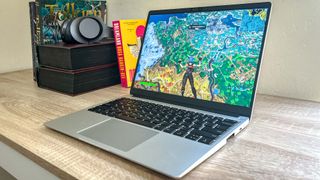
After one week
I've always been a tinkerer, and not being able to get into my laptop and upgrade it has been one of my biggest frustrations of these portable computers. The Framework Laptop 13 changes all of that by bringing unparalleled repairability and upgradability.
Fancy a different configuration of ports? No problem, those expansion cards can give you more USB-C sockets, HDMI, an SD Card slot and much more.
You can also get into the internals too, which means you can switch the battery when the current one dies out, upgrade the RAM or even switch out the motherboard if you want the new generation chip. It took me right back to all those DIY projects of my past (yes the shelves were crooked, but I looked cool, OK!?).
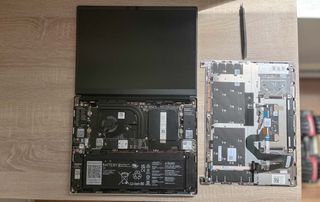
And even better? None of that focus takes away from the functionality of actually using a laptop. The Intel CPU in our test model kept things smooth and responsive with over 30 Chrome tabs (definitely helped by the 32GB of RAM). The keyboard feels surprisingly solid to type on, and comes with a smooth backlighting to help you work by night, and the display is bright and colorful (465 nits to be exact from our testing).
What this essentially means is you're not losing that tight integration of parts that you'd get from a laptop you can't open up. Plus, it's even a little lighter than the MacBook Air at 2.6 pounds.
After one month
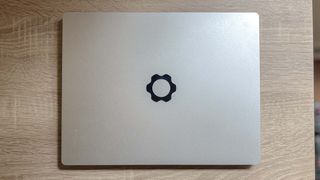
One month in, I was still loving my time with the Framework Laptop 13, but two things started to irk me a little.
First of all, I'm not sure whether this was a result of needing to be able to open it up, but the cooling works overtime here. The fans can kick up quite a storm when you're doing mid-to-intensive work or casual gaming.
Second, using this as my daily driver made me aware of the key depth being a little shallow on the keyboard. It's a small thing, but without that cushioned landing and depth, it can start to get a little tiring to type over long periods of time.
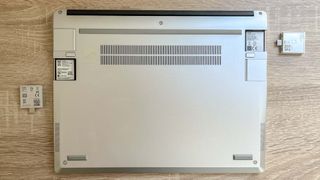
And finally, I started thinking about the decent experience I had with the Framework 13 and comparing it to the price. For the specs you get, you're paying a lot for the privilege of repairability and upgradeability.
I get it's a long-term investment, but I'd think carefully about whether that ability to get all in there makes sense for you at prices going up to (and over) $2,000 for mid-range specs.
Read the full review: Framework Laptop 13 (2023)
The best gaming laptop
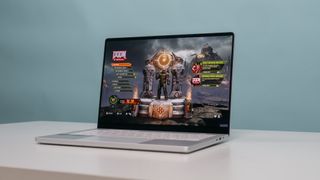
Specifications
Reasons to buy
Reasons to avoid
| Test | Results | How it stacks up |
|---|---|---|
| Battery life | 6:45 tested (non-gaming) battery life | ★★★☆☆ |
| Performance | Great for work and gaming | ★★★★★ |
| Display | Screen looks greatand accommodates high-frame rate gaming | ★★★★★ |
| Design | Slim, unassuming design blends in at home or at work | ★★★★☆ |
What you need to know
The Asus ROG Zephyrus G14 is one of the best gaming laptops on the market for most people because it's powerful, easy to carry and offers best-in-class battery life (for a gaming laptop). The newer models offer a better, brighter screen than earlier models, with good speakers and an AMD CPU and Nvidia GPU combo that delivers solid gaming performance. This model also has a webcam built into the top bezel of the display, a convenience for video calls that earlier models lacked.
However, in our testing lab we found the Zephyrus G14 can't always deliver better performance than similarly-priced gaming laptops, and the webcam isn't very good. Still, you'd have a hard time finding a better gaming laptop (that can also double as a work or school laptop) for this price.
Buy it if
✅ You want a gaming laptop you can take to class: You can find gaming laptops with lower price tags, bigger screens or more powerful innards, but you won't find many with better battery life, or that look as good on a desk.
✅ You want a beasty gaming machine: PC diehards have strong feelings about Intel vs. AMD vs. Nvidia components. With the AMD Ryzen 9 8945HS and RTX 4070 GPU, the Zephyrus G14 delivers impressive frame rates in all your favorite AAA titles.
✅ You care about a good screen: That 3K OLED panel is a real marvel to look at — presenting all your favorite games with a real HDR quality that pushes impressive color and a deep contrast ratio.
Don't buy it if
❌ You want more than 14 inches: The 14-inch (2,560 x 1,600 pixels) 120Hz display on the Zephyrus G14 is great, but it's a little small to really enjoy playing games to full effect. You could always hook the laptop up to one of the best gaming monitors, but if you want a larger canvas for gaming on the go you should look elsewhere.
❌ Webcam quality matters: The 108u0p webcam in the latest ROG Zephyrus G14 leaves a lot to be desired, and if you use it for streaming you'll hardly look your best.
The bottom line
💻 The Asus ROG Zephyrus G14 is a great gaming laptop, delivering a potent blend of performance, portability and power efficiency. The bright 16:10 120Hz display makes games and movies look great, while the speakers sound good enough that you won't feel compelled to use headphones.
The review diary
Read the deep dive ▼
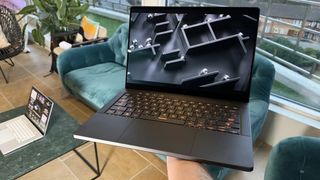
After one week
"This is a MacBook Pro!" I exclaimed when holding the redesigned Asus ROG Zephyrus G14 in my hands for the first time. And indeed, there is some shared inspiration — that all-aluminum shell looks and feels very familiar (bar that tasteful slash lighting).
But that's no bad thing when you realize it's a gaming laptop, as it automatically becomes the best looking notebook of this class. No cringeworthy RGB monstrosity that looks like a whole car on your table — looking like a Twitch streamer with zero viewers and negative charisma.
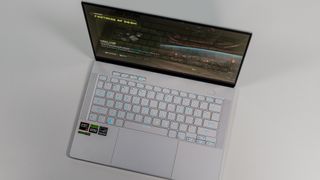
It's thin and light at 3.3 pounds, and most importantly, impressively powerful too. That pairing of AMD CPU and RTX 4070 GPU makes for a seriously zippy machine when it comes to AAA games — Cyberpunk 2077 running at over 90 FPS in high detail mode with all the ray tracing and DLSS frame gen turned on, for example.
And of course, all of this is presented in brilliant detail and color on that mouthwatering OLED panel — bringing a high resolution and zippy refresh rate for making portable gaming look so sexy with its explosion of color and a deep HDR contrast ratio.
After one month

After a month, I'd settled into that perfect all-purpose flow of owning a great gaming laptop. By day, the high-specced internals kept everything moving at a blazing pace — no matter how many Chrome tabs, Photoshop edits and intense multitasking moments I threw at it. Not only that, but Asus has paid real attention to give this a great-feeling keyboard and touchpad for working on too.
Then when you're off the clock, it's time to game, and from hitting 80 FPS in Alan Wake II to a blistering 106 FPS in Marvel's Spider-Man, its a mesmerizing experience to have on-the-go or even to play in bed if you'd rather not go PC game at your desk. No judgement here, I'm that kind of lazy too.

Just be sure to keep that charger close by because (unsurprisingly) battery life is bad. Don't get me wrong, you're getting at least some longevity when you're doing work, but when under pressure, you'll struggle to get over an hour on one charge.
Oh, and also, I took this to a work meeting, and nobody really noticed that I was using a gaming laptop. That's a huge win given the various laptops I've give me the aura of "144Hz refresh rate screen, 1FPS social skills."
Read the full review: Asus ROG Zephyrus G14
The longest-lasting laptop
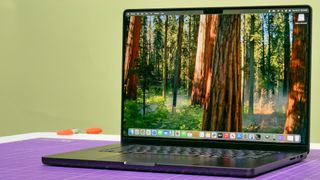
Specifications
Reasons to buy
Reasons to avoid
| Test | Results | How it stacks up |
|---|---|---|
| Battery life | 20:46 hours of tested battery life | ★★★★★ |
| Performance | Speedy at prosumer tasks | ★★★★☆ |
| Display | Gorgeous mini-LED | ★★★★★ |
| Design | Premium, durable design | ★★★★★ |
What you need to know
The new MacBook Pro 16-inch (M4 Pro, 2024) occupies the middle spot between the more affordable 14-inch MacBook Pro M4 and the more powerful (and expensive) MacBook Pro 16-inch M4 Max. It’s a laptop for those who want a 16-inch MacBook Pro but don’t want to spend an extra $1,000 for an M4 Max model.
This laptop sports the same practical design as modern MacBooks, alongside fast M4 Pro-driven performance and nearly 21 hours of battery life. That makes it the best laptop for battery life, and as before, you also get a gorgeous Liquid Retina XDR display, full-height function keys, amazing speakers and plenty of ports.
Buy it if
✅ You want a fast MacBook: While you shouldn’t expect this to match the video-crunching power of the beefier M4 Max Max MacBook Pro, the M4 Pro-equipped 16-inch MacBook Pro is one of the fastest laptops on the block.
✅ Battery life is key: The 16-inch MacBook Pro with M4 Pro set a new high-water mark for battery life when we tested it, lasting for nearly 21 hours in our battery endurance tests. That's one of the longest-lived laptops we've ever tested.
✅ You don’t want to pay for an M4 Max model: If you want a 16-inch MacBook Pro but don’t want to spend an extra $1,000 for an M4 Max model, this M4 Pro-driven laptop is the best bet as it still offers fantastic performance and epic battery life.
Don't buy it if
❌ You’re on a budget: While this laptop is cheaper than an M4 Max MacBook Pro, it’s still an expensive device. If you’re on a budget and mainly want a notebook for work or watching videos, the $1,299 15-inch MacBook Air M2 is a better choice.
❌ You need more power: Conversely, if you’re a professional content creator or gamer who needs as much processing power as possible, you’re better off with an M4 Max MacBook Pro.
❌ Notches bug you: There's a little notch in the center of the top bezel where the camera housing sits, and while most of us get used to it some folks really hate the way it looks. If that's you, consider another laptop.
The bottom line
💻 The 16-inch MacBook Pro with M4 Pro delivers some of the best battery life of any laptop we've tested to date, along with great performance, a beautiful display and a refined design.
The review diary
Read the deep dive ▼
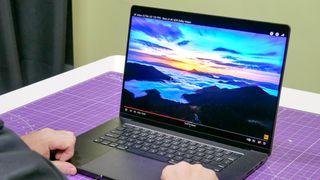
After one week
If you’ve seen one MacBook Pro, you’ve seen them all. Apple hasn’t budged from the design it introduced four years ago, and why should it? It’s a super upmarket, super durable and ruthlessly utilitarian-looking laptop — sporting a Space Black color that makes it look like the kind of laptop Batman whips out to work on his sigma TikTok compilations (yea, he seems like that kind of guy).
And with that, you’re getting the same deliciously tactile keyboard and gigantic trackpad for peak ergonomics, the same port array that is a little restricted in quantity but decent in variety, and the same display notch that takes a week or so to get used to. Just keep an eye on how many taskbar icons you have up top, as they can disappear behind it!
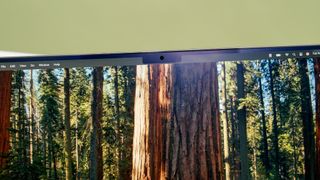
But the real superpowers here come in two forms. First, if you’re sick of seeing your face in the display glass, Apple offers a nano-textured option that is a night and day difference. Working in my local sunlit park is usually a no-go, but with this, I could see everything clearly without a single reflection.
Second, and most importantly, that M4 Pro chip is an absolute monster. We could tell you all about our benchmarking (Geekbench 6 scores peaking at 3,910 for single-core and 22,822 for multicore by the way), but let’s talk more practically.
With over 30 Chrome Tabs, Apple Music blaring and Photoshop rendering some deep RAW photo edits, I was able to export a complex 4K edit of a 10 minute video in Final Cut Pro in a little over a minute. This is ludicrous power for pro workers and content creators.
After one month
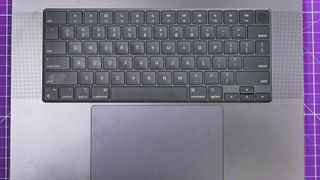
Look, we all already know that Apple Silicon has been a minor miracle when it comes to battery life and heat dissipation. But after a month of powering through intensive workloads on long haul flights, train journeys that seem to last forever and in the local cafe without my plug, you really start to appreciate that epic stamina.
And at just under 21 hours on one charge when we tested it, it’s no surprise that this is pure worry-free battery life. Even better is that the M4 Pro does all of this without chucking out a lot of heat with the fans or getting warm. This is an impressively efficient and powerful chip.
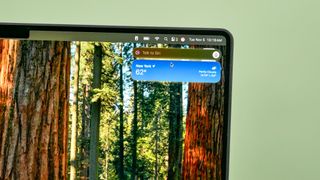
But then, you come across Apple Intelligence. Don’t get me wrong, the ability to rewrite what you type in different tones is kind of helpful, but the rest of the suite, such as the sometimes rather funny notification summaries, doesn’t really contribute much. One mild heart attack at messages from my Fiancée saying she saw a break up on Love Island and asking if I was OK being summarized as “Break-up. Hopes you are OK,” I swiftly turned it off.
Read the full review: MacBook Pro 14-inch (M4 Pro, 2024)
The best MacBook Air alternative
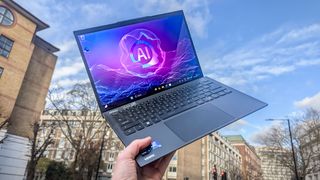
Specifications
Reasons to buy
Reasons to avoid
| Test | Notes | How it stacks up |
|---|---|---|
| Battery life | 14:27 tested battery life | ★★★★☆ |
| Performance | Snappy for multi-tasking | ★★★☆☆ |
| Display | OLED bursting with color | ★★★★★ |
| Design | Extremely lightweight and compact, but fragile | ★★★★☆ |
What you need to know
The MSI Prestige 13 AI+ Evo (from $1,399) isn’t just a fantastic MacBook alternative due to its incredibly lightweight design and compact size, but it also packs nearly as much power as Apple’s excellent offering. That says a lot for this excellent 13-inch laptop, especially if you prefer Windows over macOS.
Weighing just 2.13 pounds (under 1kg), this laptop makes for a great travel companion for on-the-move professionals or remote workers. With great performance from its Intel Lunar Lake chip and a gorgeous 2.8K OLED display to watch all your favorite shows on, it’s hard to go wrong with this featherweight machine.
Buy it if
✅ You need power and portability: The MSI Prestige 13 AI+ Evo’s Intel Core Ultra 7 258V chip and 32GB of DDR5 RAM as standard can handle multi-tasking, creative apps and more — all in a delightfully small package.
✅ You enjoy a gorgeous display: With a 13.2-inch 2.8K (2880 x 1600) OLED screen, this laptop is great for binging your favorite shows on, and it even offers greater colors than a MacBook Air.
Don't buy it if
❌ You need a sturdy laptop: Despite its welcome light weight, the MSI Prestige 13 AI+ Evo can feel cheap and a tad fragile, with plenty of flex on the lid and keyboard. For its premium price, it should feel a lot more durable.
❌ You’re looking for next-gen AI: Aside from some usual Copilot+ features and effects in video calls, this isn't the AI machine that will change the way you’ll use a laptop — regardless of being “AI+.”
The bottom line
💻 The MSI Prestige 13 AI+ Evo may be a pricey notebook, but it delivers on its promise of delivering excellent performance in a lightweight design, making for a fitting MacBook alternative for Windows fans.
The review diary
Read the deep dive ▼
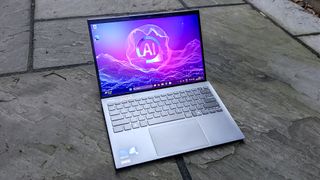
After one week
Seeing as MSI has come a long way with its Prestige lineup of laptops, now bringing “AI+ Evo” into the fold, I had high hopes for the Prestige 13 AI+ Evo. Fortunately, it exceeded my expectations right off the bat, and that all came down to its light weight and portability.
I know it’s extremely light, but I didn’t realize just how light it was until I picked up my M3 MacBook Air and compared the two laptops. There’s a noticeable difference, and made me realize that no, the MacBook Air isn’t the lightest laptop around. At just 2.13 pounds (that’s just under 1kg), I barely felt the Prestige 13 AI+ Evo in my backpack while traveling to and from the office. As far as portable laptops go, it’s already a winner.
It isn’t just about design, as this 13-inch laptop also gets brownie points for its performance. It can’t quite keep up with the MacBook Air’s M3 chip or the Dell XPS 13’s Snapdragon X Elite processor, but the latest Intel Lunar Lake CPU it holds is more than enough to help me juggle dozens of Chrome tabs without breaking a sweat. Plus, it’s even up for some light gaming, but not nearly on the level of Cyberpunk 2077.

I also found that I didn’t need to charge the Prestige 13 AI+ Evo as much as I thought. In our battery tests, it lasted over 14 hours, and in real-world usage, I could get through a day without needing a charge. For my daily tasks, from working on Google Docs to streaming shows, that’s wonderful.
Speaking of watching shows, that 13.2-inch 2.8K (2880 x 1600) OLED display is quite the eye-catcher. I adored the punchy colors and clear details in shows like “American Primeval,” and as someone who consistently binges TV series and movies, this was a huge perk to have.
As for all the AI features in this “AI+” laptop? Aside from checking out what’s available, I haven’t put them to much use. Well, that’s because I don’t believe they’re particularly essential.
After one month

With a month under my belt, the MSI Prestige 13 AI+ Evo still excels as a go-to laptop for travel. The Intel Core Ultra 7 258V chip and 32GB of RAM under its hood have let me get on with tasks without any hiccups, stutters or shutdowns, and its battery continues to get me through the majority of the day. It’s a treat not having to lug around an oversized or overweight laptop, especially if you’re constantly on the move.
I’ve also frequently used the laptop purely for its display, watching movies in great detail as I whip up a meal in the kitchen. That’s another strength I realized, as the laptop is light and compact enough to take around with me anywhere, almost acting like a tablet.
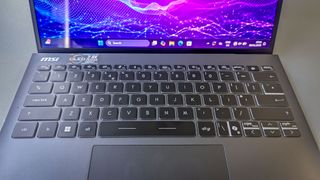
I have been worried about the flex in its keyboard and lid though. While it pays to be careful with laptops, the Prestige 13 AI+ Evo needs more care, as its lid and keyboard have too much flex. Aside from still barely using its AI features, I can see this laptop being a favorite for fans of portable notebooks.
Read the full review: MSI Prestige 13 AI+ Evo
The best 2-in-1 laptop
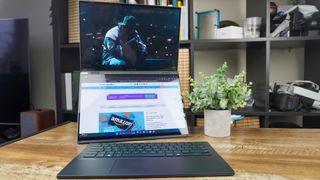
Specifications
Reasons to buy
Reasons to avoid
| Test | Notes | How it stacks up |
|---|---|---|
| Battery life | 9:28 tested battery life | ★★★☆☆ |
| Performance | Intel Core Ultra 200 series pulls ahead | ★★★★☆ |
| Display | Vivid OLED displays | ★★★★★ |
| Design | Impressively thin, light and durable | ★★★★★ |
What you need to know
A new king of 2-in-1 laptops has taken the throne. Asus has refined the new Zenbook Duo it launched last year with a speed increase to make this a multitasking marvel unlike anything else on this list.
That comes down to three reasons. First, the gorgeous dual OLED displays give you a much bigger canvas to work across. Second, the detachable keyboard and touchpad is the best I’ve used in a 2-in-1. And finally, starting at $1,599, this is good value for money for what you get.
Buy it if
✅ You’re a multi-screen multitasking machine: If you’re working in front of multiple monitors on your day-to-day, going back to a single laptop screen can be constricting. Well, expand to two gorgeous 3K OLED touchscreen panels and in the words of ‘Step Brothers,’ there’s so much more room for activities!
✅ You need some strong performance under the hood: The Intel Core Ultra 9 285H makes impressive gains in performance and graphics, to the point that it beats Snapdragon X Elite. This ensures smooth multitasking across every app window you snap on both displays.
✅ Ergonomics matter: In a lot of 2-in-1 laptops, the keyboard gets compromised. Asus’ detachable board here is amongst the best I’ve typed on with a nice tactile feel to every key press and mouse click. Plus, the latency free multi-touch makes zipping across Windows a breeze.
Don't buy it if
❌ You need long battery life: That chip upgrade has compromised the battery life a bit, to the point where you’re looking at just over 6 hours on one charge with both screens running at 120Hz.
❌ You need a lot of ports: It’s not the stingiest laptop I’ve seen in terms of ports, but with only a couple of Thunderbolt 4 Ports, a USB-A, HDMI and headphone socket, it’s a little limited.
The bottom line
💻 The Asus Zenbook Duo formed a paradigm shift in dual-screen multitasking last year — bringing dual-screen laptops to the masses at a more affordable price. For 2025, the speed increases under the hood make it all the more mighty. Pair this with mesmerizing OLED displays and fantastic ergonomics, and this is a top machine for both work and play. Just watch out for that battery life.
The review diary
Read the deep dive ▼
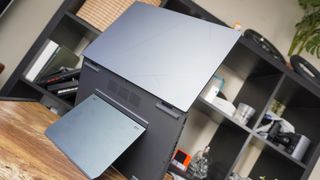
After one week
Last year, Asus made one of its best decisions as a company — ditching the weird letterbox second screen and making the Zenbook Duo a full dual-screen laptop. It was one of my favorite systems of 2024, and now it’s back with a refresh in 2025 — firmly planting it on top of the throne of 2-in-1s.
Why? Well I’ve tried other foldables and two-screen systems, and the problems are always the same: durability is a problem, the keyboard sucks, and they’re always underpowered because of the limited amount of space in the chassis.
After a week, I quickly realized that Asus said “hold my beer” and overcame each and every single one of this. It all begins with a great utilitarian look that doesn’t look like the weird sandwiches you get from other foldable, which is military-grade tested for durability. Throwing this in your backpack is no problem for it!
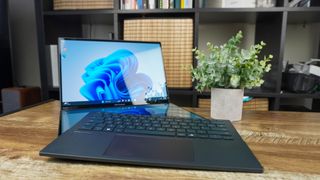
Following that is easily the best detachable keyboard and touchpad in the business. Typing and clicking is a pure tactile joy in whatever orientation you use the Duo. And finally, the jump to Intel Core Ultra 200 series brings a big speed boost to performance, SSD loading speeds and graphics — perfect for a varied workload jumping between creative apps, office apps and browsers.
And I can’t let this moment pass without talking about the real main event here in those gorgeous OLED panels! The color is simply *chef’s kiss* and while I’m supposed to say they’re great for multitasking between more admin-based work and content creation, they’re also great to watch Netflix on one panel while you’re supposed to be working on the other.
After one month
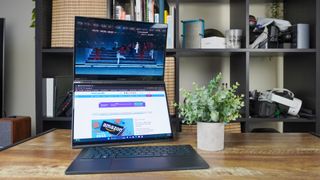
At roughly the 3-week mark is when I ran into one unexpected obstacle, and that’s the weird looks when you pull this out in public. Not to say it happens everywhere — if I went to my local cafe that is usually full of techies, nobody batted an eyelid. But in the bar, I got a lot of “who’s that weirdo” double takes with this tower of screen in front of me.
If you can handle those onlookers, don’t let them get in the way of a good time! But I did feel like the equivalent of being one of those prats who walk around in public wearing a VR headset.
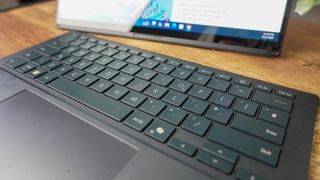
That being said, though, when the quick second-takes stopped, having this multitasking marvel on-the-go was significant for split-screen working — having Apple Music, my to do list app and Photoshop ready in a snap on the bottom screen and all the Chrome tabs up top. And with all this, the Intel chipset in here didn’t break a sweat.
But it did reveal one issue to me. With the additional horsepower under the hood, battery life has taken a dip. It’s now just over 6 hours in our testing, and in real world use, I recommend keeping a charger with you as it does drain pretty quickly under intense pressure
Read the full review: Asus ProArt PX13
The best MacBook Pro alternative
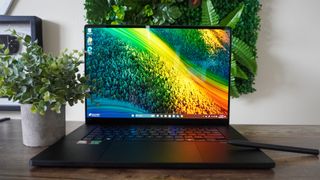
Specifications
Reasons to buy
Reasons to avoid
| Test | Notes | How it stacks up |
|---|---|---|
| Battery life | 9:32 tested battery life | ★★★☆☆ |
| Performance | Great for intense creative workloads | ★★★★☆ |
| Display | A mindblowing 4K OLED touchscreen display | ★★★★★ |
| Design | Beautifully restrained aluminum construction | ★★★★★ |
What you need to know
The Asus ProArt P16 takes the familiar aluminum unibody enclosure of the ROG Zephyrus G16, classes it up a little and repurposes it for creators. It sounds like a small change, but the big updates on display here make it a true masterpiece of a portable creation station.
That 4K OLED display is super crispy and color accurate for crucial edits, the combination of AMD Ryzen AI 9 and RTX 4070 power through any and all tasks you throw at it, and the super responsive touch screen + DialPad control give you the options to make the most finite of changes to your creations.
Buy it if
✅You’re looking for a Windows 11 laptop for creativity: Whether you’re workload heavily involves Photoshop or Premiere Pro, or if you have a passion for music creation in Pro Tools, the sheer performance potential of this machine will keep up with any demands.
✅ You want confidence in the color of your work: Not every OLED display is the same. They can look amazing, but not be calibrated for accuracy. Every ProArt P16 is color calibrated so you can be sure that what you’re working on is true to what it will look like in real-life. Plus that display is simply gorgeous.
✅ You want a laptop you’re proud to whip out in public: A lot of laptops with dedicated GPUs can look a bit garish. The ProArt P16 is very demure and very mindful with its sleek aluminum shell, stellar keyboard and responsive touchpad with DialPad to dial into your creativity.
Don't buy it if
❌ You value battery life highly: For the general day-to-day, the stamina is OK. But any additional pressure like RAW Photoshop editing will drain it fast.
❌ You need lightning fast loading speeds: The SSD loading times in here aren’t overtly bad, but there are far faster options out there for transferring dense files — like the MacBook Pro.
The bottom line
💻 The Asus ProArt P16 is easily one of the best creator laptops you can buy — packing stellar performance, a fantastic display, great ergonomics and AI smarts into a carefully considered and sexy chassis.
The review diary
Read the deep dive ▼
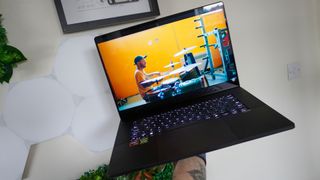
After one week
I’ve used MacBook Pros for a while now, so you already know it’d take something mesmerizing to drag me away from the Apple ecosystem. Well, Asus went ahead and did it with the ProArt P16. Lean and mean in matte black aluminum, my first week showed me this is essentially a near-perfect laptop for creators.
It all begins with the window into your content — a mind-blowing 16-inch 4K OLED touchscreen display, which has been Pantone color calibrated for a super accurate representation of whatever creation you’re working on.
At 60Hz, you’re not getting anything zippy that could use those powerful internals for gaming, but that’s not the purpose here. However, that super zippy touch response and included stylus makes this a spectacular canvas for your artistic endeavors.

Of course, for this to be something for prosumers, you need prosumer-grade specs. And the team has absolutely delivered by choosing the AMD Ryzen AI 9 HX 370 CPU and RTX 4070 GPU pairing. There was no single 4K video render, 3D animation, photo edit or complex sketch that slowed this system down one iota. This is a mean machine that can handle the entire spectrum of professional on-the-go work.
And it does it all with a great keyboard and touchpad, all stashed in a sleek shell (just 0.7 inches thin) that has no sign of a display notch — take that, Apple!
After one month

A few weeks in, I really figured out a great work/play flow to make the absolute most of the ProArt P16. Because hey — even professionals need to blow off some steam, so being able to play Cyberpunk 2077 at 4K 50 FPS with DLSS turned to performance mode made for a gameplay experience that would make my PS5 very nervous in-between all the advanced rendering work.
And I found that the battery life is a bit of a mixed bag… Let me explain. Over the month, I was seeing that if my workload was a rather simple one of Chrome tabs and Apple Music, I saw my longevity going impressively long for a beast of this spec. In our testing it achieved 9 hours and 32 minutes, after all.
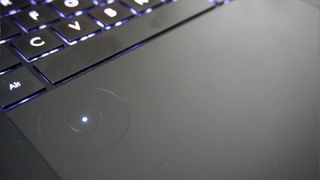
But if you are to do 4K edits and renders, and really start to pump out some power (fair warning — those fans are loud if you do), that stamina is hella leaky. Just be aware of what’s on your to-do list and keep that charger nearby.
Plus, the jury is out on that DialPad. Personally, I loved using it as a mini macro controller to quickly access brush tools in Photoshop, but for every one of me, there’s another person that sees it as a pure gimmick to keep turned off.
Read the full review: Asus ProArt P16
The best MacBook Pro
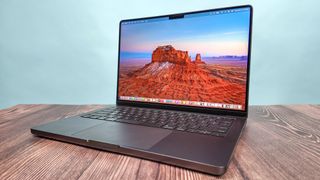
Specifications
Reasons to buy
Reasons to avoid
| Test | Notes | How it stacks up |
|---|---|---|
| Battery life | 18:31 tested battery life | ★★★★★ |
| Performance | Great for video editing | ★★★★☆ |
| Display | Gorgeous mini-LED display | ★★★★★ |
| Design | Premium, durable design | ★★★★★ |
What you need to know
The 14-inch MacBook Pro with the M4 chip is one of the most powerful laptops we’ve yet tested, which is all the more impressive when you consider its svelte 3.4-pound chassis slips into a backpack with ease.
Of course, that's no surprise given that the company has been iterating on this design for years. The addition of an M4 chip under the hood takes the 14-inch MacBook Pro to new heights, making it the best MacBook Pro for most folks thanks to its unbeatable combo of size, performance and price.
Buy it if
✅ You need to edit videos on the go: And I'm not talking iMovie clips, either - I'm talking about working with Final Cut and Adobe Premiere to edit videos while you're away from desk. The M4 chip is built for this kind of work, and it will serve you well.
✅ You plan to work outside often: The M4 MacBook Pro is the first to come with the optional nano-texture glass coating, which costs $150 extra but helps stop glare from bright light-which is great when you work outdoors a lot.
✅ You want a MacBook that'll last for years: M4 MacBooks are still (barely) viable, so it stands to reason that M4-driven notebooks could potentially last you 5-10 years. This could help justify the admittedly high initial price.
Don't buy it if
❌ Gaming is important: The M4 MacBook Pro runs Mac-compatible games pretty well, but it's not the best gaming laptop for the money. If you care about gaming performance, go with one of the best gaming laptops instead.
❌ You own a MacBook Pro M3: The M4 MacBook Pro is more capable than its predecessor, but not by much. If you already own a recent MacBook Pro and you're not craving the nano-texture coating, there's no reason to rush out and upgrade.
The bottom line
💻 The MacBook Pro 14-inch M4 retains the same fetching design and gorgeous mini-LED display as its predecessors while delivering unprecedented speed and power efficiency. If you want a portable Mac more powerful than a MacBook Air but can't afford the extra expense or weight of a 16-inch MacBook Pro M4, this is the best MacBook Pro for you.
The review diary
Read the deep dive ▼
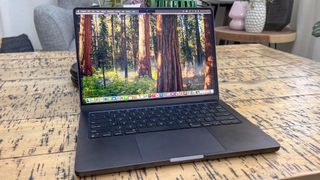
After one week
The 14-inch MacBook Pro is a lot more of the same but with updated internals, which is absolutely not a bad thing. The utilitarian shell may be getting a little old in its 4th generation, but it's still an ultimately damn good-looking laptop with an impressive durability and utilitarian aesthetic — making it look like something that is ready to work hard.
And that much is obvious with the M4 chip inside offering serious horsepower to smash through tasks. Of course, it's not the fastest Apple offers (I'd go for the M4 Pro MacBook Pro if you need that).
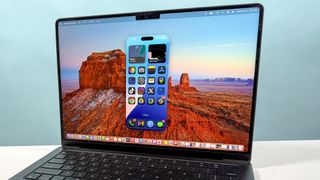
But for the vast majority of content creators, M4 is more than enough, which when paired with that gorgeous color-accurate 14.2-inch Liquid Retina Display made for a great system to whip up some 4K TikToks on in Final Cut Pro.
Oh, and shout-out to that battery life, which we found was 18 hours and 31 minutes in our own testing. In the clutch moments I found myself in, from a long haul flight to sitting in a cafe with no available power outlets, I had no care in the world for my MacBook's stamina.
After one month

One month in, and my love affair (mostly) continued... What do I mean mostly? Well there were some rocky moments. First comes back to why I always love a gaming laptop — having the horsepower to get intensive workloads done and the GPU to handle AAA gaming.
The M4 MacBook Pro absolutely nails the first part of this formula, but the second part? Not so much. That isn't to say the situation's getting better, as more developers including CD Projekt Red are rewriting their games for macOS (can't wait to fire up Cyberpunk on a MacBook)!
But with that in mind, the M4 chip in here isn't the best at gaming with frame rates hovering around 20-30 FPS in the likes of Tomb Raider and Borderlands 3. You can get better gaming performance in general by spending the same amount of money.
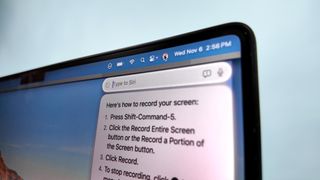
And second, with a lot of working with high-capacity files (such as 200GB of 4K video files), a fast SSD is critical, and this MacBook Pro is surprisingly a little on the slower side. In fact, it's a touch slower than the M3 MacBook Pro. This means that you'll be waiting for a little longer than usual when it comes to transporting files (30 seconds extra in my example above).
Read the full review: MacBook Pro 14-inch M4
Also tested
I test and review hundreds of laptops every year, and just because they don't all make this list doesn't mean they aren't good machines.
No, there are loads of great laptops that don't quite achieve the level of excellence needed to lead the pack. But they're still great machines, and they're worth considering if you're looking for a specific feature or another laptop you want isn't available.
Below, I've gathered all the great laptops we've tested which don't quite make this list, but are still good alternatives well worth considering if they meet your unique needs, or if you can't find your first choice on sale.
MSI Prestige 16 AI Evo (★★★★☆)
This is a big, speedy Windows 11 laptop with a good (if glossy) 16-inch screen, good performance and 15+ hours of tested battery life thanks to its Intel Core Ultra 2 CPUs. It's not great for gaming, but it is nice for getting work done on the go thanks to its surprising portability.
Read the full MSI Prestige 16 AI Evo review.
Microsoft Surface Laptop 7 (★★★★☆)
The Microsoft Surface Laptop 7 ($999 to start) is the first Surface Laptop to ship with a Snapdragon CPU inside, and the extra power and battery life it affords make this the best Surface Laptop yet. Good battery life and performance, along with a comfy keyboard and Wi-Fi 7 support, make this a great ultraportable for getting work done.
Read the full Microsoft Surface Laptop 7 review.
Battery benchmarks: comparison
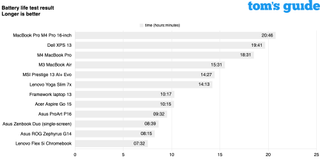
Me and my team run every laptop through a series of battery tests to see how long it actually lasts on a full charge, which is one of the key deciding factors for most people when buying a laptop. You want to know about how long a laptop will actually last on a full charge so you know when to carry a charger with you, and when you're safe to leave it at home.
Note that these tests do not reflect real-world use patterns since we have to set every laptop to the same settings in order to do fair comparisons. Thus, while the times listed here are accurate and useful as a comparison point, your own experience with a laptop's battery life will likely vary quite a bit.
This is because when we run our battery test we set the laptop's display to 150 nits of brightness and have it endlessly browse the web via Wi-Fi until it dies. However, when you use your laptop you're likely adjusting brightness on the fly, doing all sorts of different tasks while perhaps listening to music or watching a video at the same time, and generally putting the machine through more of a workout than it gets in our test.
So while I stand by our testing and the battery life results, I want to be clear that your own experience will vary!
How to choose the best laptop for you
What kind of power do you want?
If you only need something basic for surfing the web, consider a Chromebook or a cheap Windows laptop with an Intel Core i3 processor and 4GB of RAM, because that's the minimum you should expect from a modern laptop.
If you want something that feels speedy and can handle more than basic writing and web browsing, look for beefier laptops with at least an Intel Core i5 CPU from the past few years, 8 to 16GB of RAM and a 256GB to 512GB SSD for storage.
What kind of games (if any) do you want to play?
Most laptops feature integrated graphics chipsets that are built into their CPU, which usually struggle to run demanding modern games but can often handle old or less graphically-demanding games.
But if want to play the latest and greatest games on your portable PC you'll want a dedicated gaming laptop, because they come with more powerful discrete laptop graphics cards, more RAM, better cooling systems and other advancements designed to make them decent gaming machines.
Of course, you have to make compromises when buying a gaming laptop that you don't have to make when buying one of the best gaming PCs, since your laptop needs a beefy battery and enough room to be able to discharge heat effectively without cooking its innards.
How big of a laptop do you want?
Think about how often you might carry this laptop around. Machines such as the Dell XPS 13 and MacBook Air are remarkably light and slim, but their 13-inch screens are on the small side.
You can get a larger 15-inch display on a premium ultraportable like the XPS 15 and still not have to worry about weight too much, but once you start getting up into the realm of 16-inch to 18-inch screens, expect your laptop to weigh at least 3-5 pounds. As mentioned above gaming laptops are almost always several pounds heavier than thin-and-light ultraportables because they need more room for beefier components, but they offer big power in exchange.
Frequently asked questions
How do I find the best laptop deals?
Tom's Guide's crack deals team has scoured the internet and given you the best laptop deals on our favorite laptops just above. But we know they're not going to be the best options for everyone! If you're shopping around for something more suited to your tastes, here's how our team go about finding stellar savings.
First things first, establish what you're looking to buy and set a budget. It's easy to watch costs spiral and before you know it, you've dropped thousands of dollars on additional power and features you may not need. Figuring out what you want to do with your laptop and how much money you're comfortable spending is the best option. For example, saying "I want a good gaming laptop for under $1,000" will net you a whole host of great budget-to-mid-range choices.
Second, retailers are going to work really hard to make its deals look super attractive with huge percentage discounts, but don't fall for it. I've already spotted numerous deals that have actually been cheaper in the past.
As a good sense check for this, take a look at downloading the Camelizer — a Chrome extension that can run an extensive historical price check on any Amazon product. With that line graph, you can see whether that Cyber Monday laptop deal is actually a deal.
And finally, within your choice, have a think about what particular features of a laptop matter to you. If you're someone who cares about screen real estate, the choice is obvious. But if you can really stretch the graphical capabilities of that silicon with your workload, think again.
Or maybe you want the vastly increased amount of app support and customization opportunities of Windows 11, which will also net you better value for money than the MacBooks, but also lacks the simplicity of macOS. Just take a breather, think about what things matter — the software, the keyboard being good to type on, etc — and make the best judgement for you.
How much RAM do I need?
Given the current demands of apps like Google Chrome being heavily reliant on RAM and the ever increasing move to more AI processes running in the background, I'd aim for at least 16GB of RAM.
This is also more than enough for a solid amount of multitasking across intense apps, and even some AAA gaming too. If you're the pro-est of pros, 32GB is a minimum — 3D animation tasks and running the most intensive games alongside an OBS window for Twitch streaming will need that headroom.
How we tested these laptops
How we test the best laptops
In our never-ending quest to find the best laptops, I put every computer we test through a barrage of synthetic and real-world tests to benchmark how well it performs compared to the manufacturer's claims, and compare how good it is relative to the competition.
These tests include, but are not limited to: measuring the average brightness and color quality of each laptop's display using our in-house colorimeter, using a heat gun to measure the heat generated by the laptop after 15 minutes of strenuous work, and using a mix of real-world and synthetic benchmarks to test how well a laptop performs at various day-to-day tasks.
I put all laptops through the Geekbench CPU performance benchmark tests as well as various 3DMark tests to measure graphics capabilities. I also run a file transfer test to measure how fast a machine's hard drive is, a video transcoding test to gauge how well a laptop can cut video and a custom battery test that has the machine browse the internet over Wi-Fi until it runs out of juice.
There's also gaming benchmarks that I use — testing a basic game like Sid Meier's Civilization VI: Gathering Storm to gauge how good it is at running games compared to other laptops. I use this old game because it runs on a wide variety of laptops across different prices, sizes and operating systems, so it's great for comparing performance.
Of course when testing dedicated gaming laptops, I run benchmarks for many more demanding and popular games, including Assassin's Creed Valhalla, Cyberpunk 2077 and Red Dead Redemption 2. For more information on our testing process, check out our guide to how we test.

I've been using laptops ever since 2006 — much preferring the portability and versatility of an on-the-go system rather than being locked to a desk. With an ocean of experience that dates back to the days of celebrating having a DVD drive in your laptop (yes, I feel old typing that), I'm ready to help you find the right laptop for you.
Sign up to get the BEST of Tom's Guide direct to your inbox.
Get instant access to breaking news, the hottest reviews, great deals and helpful tips.

Jason brings a decade of tech and gaming journalism experience to his role as a Managing Editor of Computing at Tom's Guide. He has previously written for Laptop Mag, Tom's Hardware, Kotaku, Stuff and BBC Science Focus. In his spare time, you'll find Jason looking for good dogs to pet or thinking about eating pizza if he isn't already.
